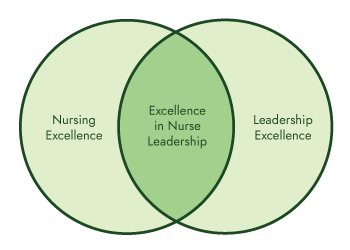A nurse can consider working toward attaining a leadership role at any point during their career. Motivation could come from a personal or professional goal, or someone may have recognized their potential and recommended them for advancement. When considering moving into leadership, nurses should assess the characteristics of effective nurse leaders to see how a leadership role could benefit their own growth and that of their organizations.
Nurses have many opportunities to observe what makes a good nurse leader. In nursing school, working with mentors and preceptors, and in care settings, nurses gain awareness of the qualities that the best leaders possess.
Judging from the different perspectives that exist across the profession, nurse leader characteristics are numerous and can vary by individual, organization, specialty, and setting — and the opinion of the person you’re asking.
It is helpful to look at the broader skill sets that signify excellence in nursing leadership and the groups of characteristics within these areas. With this more holistic view, it is easier to see where a nurse should target professional and personal development to round out their competencies. Self-assessments can help objectively determine where experience may fall short and help nurses develop the specific skills and capabilities they need to move up in the profession.
Assessing three areas of excellence
Professional organizations and industry publications have focused on three distinct skill sets that overlap:
- Nursing excellence
- Leadership excellence
- Excellence in nurse leadership

It may seem obvious that excellence in nursing leadership combines characteristics and skills from both nursing and leadership. But considering each area separately enables us to examine models from the fields of both nursing and organizational leadership that combine to create the most successful nurse leaders.
Factors outside of these areas can also impact the role of a nurse leader. As we saw during the COVID-19 pandemic, extraordinary stressors in the workplace such as a global health crisis or critical labor shortage can heighten the need for certain skills and qualities in our leaders. The top (or most in-demand) characteristics of nurse leaders will necessarily evolve, at times elevating qualities such as flexibility, versatility, and responsiveness along with other emerging needs.
Category 1: nursing excellence
In most professions, those who excel in their current capacity are the ones most likely to receive recognition and opportunities that could position them to advance. Nurses are no exception, and those who seek to move up must distinguish themselves in a field full of dedicated professionals.
The American Nurses Association (ANA) outlines competency models for both nursing practice and nurse leadership. The ANA model for standard nursing practice includes a significant emphasis on leadership, even for those who are not in formal leadership positions. Nurses must demonstrate leadership in their roles to achieve excellence in nursing.
Standards of practice
The ANA’s pyramid of nursing competencies has four levels. The foundation of the pyramid includes standards of practice. The next level includes rules and regulations, followed by a third level that includes institutional policies and procedures. The top of the ANA pyramid is where nurses advance into leadership roles to “enhance the leadership qualities, abilities, and impact of the nursing profession for the health of society.”
In all, the ANA lists 10 “standards of professional performance” that overlap with leadership competencies:
- Collaboration with patients, families, and others to build relationships
- Communication, written and verbal, with clarity and effectiveness
- Education, with an emphasis on professional development and lifelong learning
- Environmental health, as demonstrated by practicing in a safe and healthy manner
- Ethics in practice, with integrity, honesty, responsibility, and credibility
- Evidence-based practice and research, including integrating evidence and findings into practice
- Leadership, as demonstrated in the professional practice setting and the profession
- Professional practice evaluation through self-evaluation in relation to standards and guidelines
- Quality of practice, as demonstrated through creativity, innovation, and quality improvement
- Resource utilization that is appropriate, safe, effective, and financially responsible
Top interpersonal qualities in nursing
While the ANA’s list is competency-based, other sources focus on interpersonal and behavioral qualities, including the following:
|
|
Although these lists of ideal attributes are long, the similarities among them are clear. To be ready to lead, nurses must practice at the top of their profession, operate beyond their own professional spheres, and create a consistent, positive impact within their organizations.
Category 2: leadership excellence
Outside of the nursing profession, the study of leadership excellence has generated many management theories and research findings. In particular, the Transformational Leadership model has gained traction in health care and beyond as a hallmark of successful organizations.
Developed in the late 1970s, Transformational Leadership is a model in which practitioners empower their staff to succeed through encouragement and support rather than control and authoritative decision-making.
Transformational leadership characteristics
Not surprisingly, some of the key characteristics of Transformational Leadership are similar to those listed for nursing excellence. A good leader:
|
|
The Transformational Leadership model also incorporates personal characteristics such as being charismatic, visionary, and highly visible, which some may argue are not critical for success but certainly help.
Organizational leadership characteristics
Other sources add the following to the list of leadership characteristics across many industries and professions, including health care:
|
|
Category 3: excellence in nurse leadership
Drawing from both nursing and leadership excellence, nurse leaders bring the best of both to their roles. Not only do nurse leaders exemplify the highest levels of the nursing profession, they also help make those around them better — from their colleagues to those they interact with throughout their organizations.
At the intersection of nursing and leadership, more nuanced factors exist, especially during events such as the COVID-19 pandemic, which exacerbated the existing healthcare labor shortage. With nurses in short supply, nurse leaders must have the agility to take on a growing number of responsibilities. They must adapt to change and be able to successfully perform with the least possible disruption despite continuing challenges.
Leadership qualities for organizational excellence
More than just a step in an individual’s career advancement, nursing leadership strengthens organizations. In its Magnet Model framework, the American Nurses Credentialing Center (ANCC) notes that the quality of nursing leadership determines the level of organizational excellence, which in turn directly affects quality outcomes in patient care, safety, and satisfaction. In addition, good leadership increases employee satisfaction and reduces turnover.
With the growing emphasis on equitable workplaces, nurse leaders must also understand the work of diversity, equity, and inclusion (DEI) to ensure a fair and just workplace that considers the needs of all its employees. Nurse leaders are instrumental in making the profession as welcoming and supportive as possible to any individual who enters it.
Advanced nurse leadership characteristics
In addition, nurse leaders might need to draw upon these more advanced leadership qualities that have become increasingly necessary in recent years:
- An ability to help resolve conflicts that may occur in healthcare settings
- A willingness to lead during unpredictable, difficult, or dangerous situations
- Emotional and physical stamina, with regard for one’s own well-being and that of others
- A focus on practice improvement to optimize healthcare resources and technology
- Skill in managing the many people and processes that exist within a healthcare organization
- An emphasis on employee development and relationship building to create highly reliable, efficient healthcare teams
- An understanding of the need to create a culture of learning to generate intellectual stimulation that supports an environment of high reliability and evidence-based practice
Begin with a single step forward
Undertaking a journey to leadership may seem daunting, but nurses who have practiced for some time may have developed many of these characteristics already. Looking at the three areas provides a clear path that any nurse can strive for by working at the top of their nursing practice, exercising leadership in their current role, and preparing to advance.
Because healthcare organizations need more nurse leaders, every nurse should consider their capacity to lead. Acquiring leadership skills can come through work experience, educational opportunities, and professional development offered through their organization and nursing associations. The future of health care depends on more nurses taking the initiative, and their organizations should do all they can to support these efforts.

Transformational Leadership: Developing Leaders, Inspiring Employees, and Driving Change
Transformational leadership is the preferred management style of Magnet®-recognized hospitals, transforming teams and organizations to higher levels of practice. Learn about the benefits of adopting this leadership model and its four dimensions. Implement it to achieve excellence among your organizational leaders.
Download the white paper →





